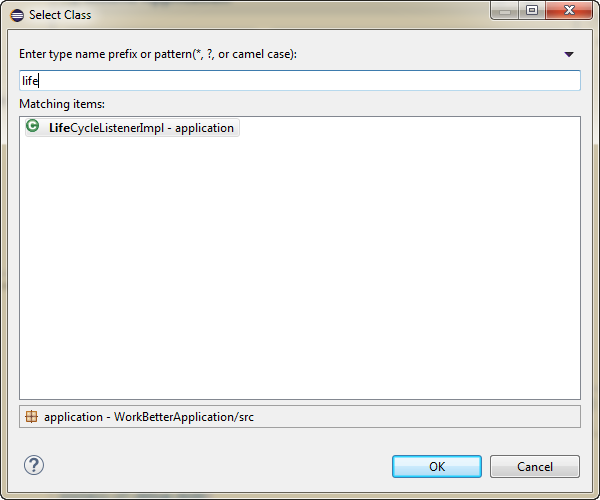10 Using Lifecycle Listeners in MAF Applications
This chapter includes the following sections:
10.1 Introduction to Lifecycle Listeners in MAF Applications
Lifecycle listeners are useful locations to write code that executes in response to specific events in your application. MAF provides lifecycle listeners where you can write code in response to application or application feature events. A typical implementation of an application lifecycle listener method may be to write code that initializes your application's database when the application starts, as described in Using the Local Database in MAF AMX, or to update a security configuration from URL parameters, as described in HowHow to Update Connection Attributes of a Named Connection at Runtime.
MAF provides the following two interfaces that you can implement to communicate with event notifications:
-
oracle.adfmf.application.LifeCycleListenerThis interface specifies the following methods that an application lifecycle listener must implement:
-
activate() -
deactivate() -
start() -
stop()
-
-
oracle.adfmf.feature.LifeCycleListenerThis interface specifies the following methods that a feature lifecycle listener must implement:
-
activate() -
deactivate()
-
You create a lifecycle listener by creating a Java class that implements the appropriate interface and registering the implementation in your MAF application, as described in Registering a Lifecycle Listener for a MAF Application or an Application Feature.
A new MAF application that you create implements the oracle.adfmf.application.LifeCycleListener interface through the default creation of the application.LifeCycleListenerImpl.java class in the application project, as shown in Figure 10-1.
Figure 10-1 Implementation of Application Lifecycle Listener

Note that the application lifecycle listener is executed with an anonymous user (that is, there is no user associated with any of its methods and no secure web service is called).
Table 10-1 describes the specific times that MAF invokes application lifecycle methods during an application's startup, shutdown, and hibernation.
Table 10-1 Timing of MAF's Invocation of Application Lifecycle Methods
| Method | Timing | When Called | Usage |
|---|---|---|---|
|
|
Called after the MAF application has completely loaded the application features and immediately before presenting the user with the initial application feature or the springboard. This is a blocking call. |
When the application process starts. |
Uses include:
|
|
|
Called as the MAF application begins its shutdown. |
When the application process terminates. |
Uses include:
|
|
|
Called as the MAF application activates from being situated in the background (hibernating). This is a blocking call. |
After the |
Uses include:
|
|
deactivate |
Called as the MAF application deactivates and moves into the background (hibernating). This is a blocking call. |
Before the |
Uses include:
|
Table 10-2 describes the specific times that MAF invokes feature lifecycle methods during a feature's activation and deactivation.
Table 10-2 Timing of MAF's Invocation of Feature Lifecycle Methods
| Method | Timing | When Called | Usage |
|---|---|---|---|
|
|
Called before the current application feature is activated. |
Called when a user selects the application feature for the first time after launching a MAF application, or when the application has been re-selected (that is, brought back to the foreground). |
Uses include:
|
|
|
Called before the next application feature is activated, or before the application feature exits. |
Called when the user selects another application feature. |
You can, for example, use the deactivate event to write the |
For more information about the oracle.adfmf.application.LifeCycleListener and oracle.adfmf.feature.LifeCycleListener interfaces, see the .
The LifecycleEvents sample application demonstrates declaring listener classes that implement both the application and feature interfaces. It registers these listener classes in the MAF application's maf-application.xml and maf-feature.xml files. For more information about this and other sample applications, see MAF Sample Applications..
10.2 Registering a Lifecycle Listener for a MAF Application or an Application Feature
You register an application lifecycle listener using the MAF Application Editor and a feature lifecycle listener using the MAF Features Editor.
To register an application lifecycle listener:
-
In the Project Explorer, expand the assembly project, then MAF and double-click MAF Application Editor.
-
In the Outline, select the application node, and in the Application tab specify the Java class that implements the
oracle.adfmf.application.LifeCycleListenerinterface in the Lifecycle Event Listener field.Note:
If you place the mouse pointer over the label for Lifecycle Event Listener, OEPE displays a tooltip describing the listener class.
Figure 10-2 Retrieving the Application Event Listener

To register an application feature lifecycle listener:
- In the Project Explorer, expand the view project, then MAF and double-click MAF Features Editor.
- Select the feature in the Features list for which you want to register a feature lifecycle listener.
- In the Lifecycle Event Listener field, specify the Java class that implements the
oracle.adfmf.feature.LifeCycleListenerinterface.
10.3 What Happens When You Register a Lifecycle Listener
By default, a MAF application that you create implements an application lifecycle listener through the creation of the application.LifeCycleListenerImpl.java class in your application's application project. The listener-class attribute in the maf-application.xml file registers this class, as shown in the following example.
<adfmf:application xmlns:xsi="http://www.w3.org/2001/XMLSchema-instance" xmlns:adfmf="http://xmlns.oracle.com/adf/mf"
version="1.0" name="NewMAFapp" id="com.company.NewMAFapp"
appControllerFolder="ApplicationController" listener-class="application.LifeCycleListenerImpl">
...
</adfmf:application>
OEPE writes an entry to the maf-feature.xml file for the listener-class attribute when you register a feature lifecycle listener. The following example shows an entry in the LifecycleEvents sample application described in MAF Sample Applications..
<?xml version="1.0" encoding="UTF-8" ?>
<adfmf:features xmlns:xsi="http://www.w3.org/2001/XMLSchema-instance" xmlns:adfmf="http://xmlns.oracle.com/adf/mf">
<adfmf:feature id="Feature1" name="Feature1" listener-class="mobile.Feature1Handler">
<adfmf:description>This is a sample feature to show the feature lifecycle handlers.
</adfmf:description>
<adfmf:content id="Feature1.1">
<adfmf:amx file="Feature1/feature1.amx"/>
</adfmf:content>
</adfmf:feature>
...
</adfmf:features>